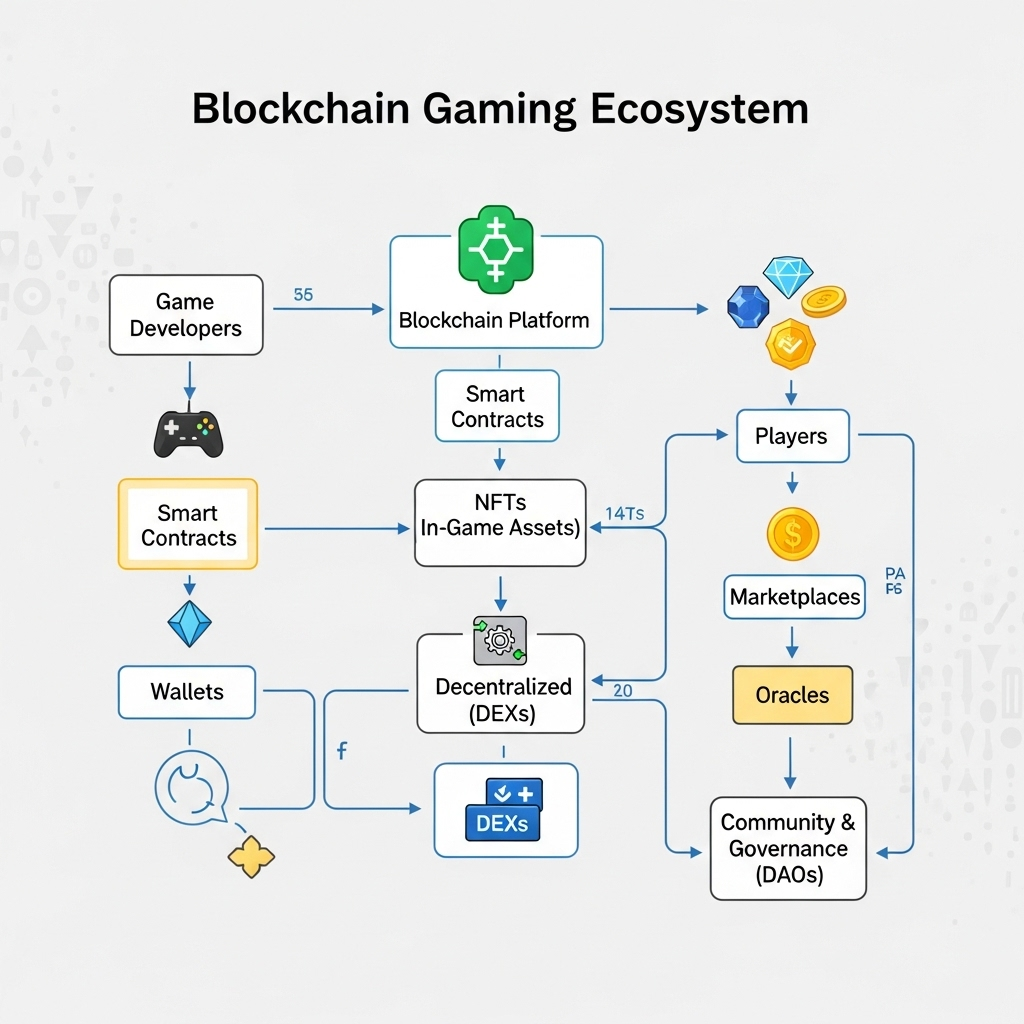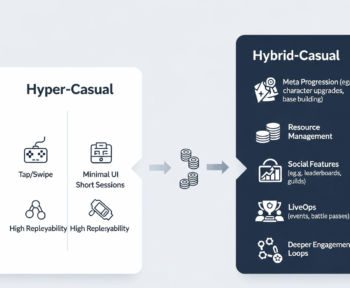The blockchain gaming sector has undergone a dramatic transformation from the speculative frenzy of 2021-2022 to a more mature, realistic market in 2025. While the initial promises of revolutionary player ownership and play-to-earn economics have been tempered by reality, blockchain technology continues to evolve within gaming, finding legitimate use cases while abandoning failed experiments.
The Rise and Reality Check
The initial blockchain gaming boom promised a revolution where players would truly own in-game assets, earn meaningful income through gameplay, and participate in game governance through decentralized autonomous organizations (DAOs). Games like Axie Infinity saw explosive growth with players in developing countries reportedly earning living wages through play-to-earn mechanics. The reality proved far more complex than the marketing suggested.
The economic sustainability of pure play-to-earn models quickly revealed fundamental flaws. These games required constant influx of new players to maintain token values, essentially operating as pyramid schemes disguised as games. When growth inevitably slowed, token values collapsed, leaving late adopters with worthless assets and negative returns on their investments. The Axie Infinity economy crash in 2022, where the SLP token lost 99% of its value, became a cautionary tale for the entire industry.
The focus on financialization over fun created games that were neither good investments nor enjoyable experiences. Players approached these titles as jobs rather than entertainment, optimizing for earnings rather than engagement. This mercenary player base had no loyalty to games beyond profit potential, creating volatile communities that abandoned games at the first sign of declining returns.
Technical Limitations and Solutions
Blockchain technology’s fundamental limitations—high transaction costs, slow processing speeds, and massive energy consumption—proved incompatible with the requirements of real-time gaming. Every item transfer, character movement, or game action recorded on-chain incurred gas fees that often exceeded the value of the action itself. Games attempting full on-chain implementation became unplayable due to latency and costs.
Layer 2 solutions and sidechains emerged to address scalability issues, with platforms like Polygon, Immutable X, and Arbitrum providing faster, cheaper transactions. However, these solutions introduced complexity and centralization that undermined blockchain’s supposed benefits. Players needed to understand bridging, wallet management, and gas optimization—technical barriers that casual gamers found insurmountable.
Hybrid architectures have become the practical standard, with games running on traditional servers while using blockchain for specific features like item ownership and marketplace transactions. This approach maintains playable performance while enabling blockchain features where they add value. However, it raises questions about whether blockchain is necessary if games remain primarily centralized.
NFT Gaming Assets Evolution
The NFT gaming asset market has matured from simple profile pictures and land parcels to more sophisticated implementations. Interoperable items that work across multiple games within ecosystems have shown promise, though true cross-game compatibility remains technically challenging. Standards like ERC-1155 enable more efficient NFT implementations, reducing costs and environmental impact.
Dynamic NFTs that evolve based on gameplay have created more engaging ownership experiences. Characters that level up, items that gain history, and land that develops based on player actions provide gameplay value beyond speculation. These implementations focus on enhancing game experiences rather than just creating tradeable assets.
The environmental concerns around NFT gaming have driven adoption of more sustainable blockchain platforms. Proof-of-stake chains like Solana and proof-of-authority networks have replaced energy-intensive proof-of-work systems for most gaming applications. However, the environmental argument against blockchain gaming remains potent, particularly when traditional databases could achieve similar functionality with minimal energy use.
Play-to-Earn Model Evolution
The pure play-to-earn model has largely been abandoned in favor of “play-and-earn” approaches that prioritize gameplay while offering economic opportunities. These games focus first on creating enjoyable experiences, with earning potential as a secondary benefit rather than primary motivation. This shift acknowledges that sustainable game economies require players who genuinely enjoy the experience.
Scholarship programs, where asset owners rent their NFTs to players in exchange for earnings shares, have evolved but face regulatory scrutiny. What initially seemed like innovative economic opportunity increasingly looks like digital sharecropping, with asset owners extracting value from players’ labor. Some jurisdictions have begun treating these arrangements as employment relationships subject to labor laws.
The integration of DeFi mechanisms into game economies has created complex financial systems that few players fully understand. Staking, liquidity provision, and yield farming within games add layers of financial risk that transform games into investment vehicles. This financialization has attracted regulatory attention, with many jurisdictions treating play-to-earn games as unlicensed securities offerings.
Regulatory Challenges and Compliance
Regulatory uncertainty remains blockchain gaming’s biggest challenge. Different jurisdictions have wildly varying approaches, from Japan’s strict NFT regulations to the Philippines’ embrace of play-to-earn. This patchwork regulatory landscape makes global distribution extremely complex, with games needing different versions for different markets.
Securities laws have become particularly relevant as game tokens often qualify as investment contracts under existing regulations. The SEC’s enforcement actions against various crypto projects have created a chilling effect, with many developers avoiding token launches entirely. Games must carefully structure their economies to avoid securities classification, limiting the economic models they can implement.
Anti-money laundering (AML) and know-your-customer (KYC) requirements add friction to blockchain games that traditional games avoid. Players must often provide identity verification to participate in game economies, eliminating the anonymity that attracted many to blockchain. These requirements also exclude players from countries with weak identity infrastructure, limiting global reach.
Successful Implementations and Use Cases
Despite broad challenges, certain blockchain gaming implementations have shown genuine utility. Digital collectible card games benefit from verifiable scarcity and transparent marketplace dynamics. Gods Unchained has created a sustainable economy where card ownership enhances rather than defines the gameplay experience.
User-generated content platforms have successfully used blockchain for creator monetization. The Sandbox and similar platforms enable creators to monetize their work through NFT sales while maintaining creative control. This model aligns incentives between platforms and creators more fairly than traditional revenue-sharing arrangements.
Esports and competitive gaming have found value in blockchain for tournament organization, prize distribution, and achievement verification. Smart contracts automate prize payouts, eliminate intermediaries, and create transparent competitive records. These applications leverage blockchain’s strengths—transparency, immutability, and programmability—for genuine utility.
Player Sentiment and Market Reality
Mainstream gamer sentiment toward blockchain gaming remains overwhelmingly negative. Major gaming communities on Reddit, Discord, and other platforms consistently reject blockchain integration, viewing it as exploitative monetization disguised as innovation. Game companies announcing NFT initiatives face immediate backlash, with several high-profile cancellations following player revolts.
The association with scams, rug pulls, and failed projects has created lasting reputational damage. High-profile failures like Earth 2 and countless abandoned projects have reinforced perceptions that blockchain gaming is more about extracting money from players than creating enjoyable experiences. Rebuilding trust requires demonstrating genuine utility beyond financial speculation.
The generational divide in blockchain gaming acceptance is notable. Younger players who grew up with digital ownership concepts are more receptive, while older gamers who remember gaming before aggressive monetization are more skeptical. This divide suggests blockchain gaming might gain acceptance through generational change rather than convincing current skeptics.
Technical Innovation and Future Potential
Zero-knowledge proofs and other cryptographic innovations promise to address current limitations. Privacy-preserving transactions could enable complex game economies without exposing player data. Scalability improvements through techniques like rollups and state channels could reduce costs to negligible levels.
Artificial intelligence integration with blockchain gaming could create genuinely novel experiences. AI-generated content verified and owned through blockchain could enable infinite, unique game experiences. Smart contracts could create dynamic economies that self-balance based on player behavior. These speculative applications suggest potential beyond current implementations.
Interoperability standards are slowly emerging that could enable true asset portability across games and platforms. The Metaverse Standards Forum and similar initiatives work toward common protocols for digital assets. However, technical standards are easier than business agreements, and companies remain reluctant to enable asset portability that might reduce lock-in.
Investment and Development Landscape
Venture capital investment in blockchain gaming has declined significantly from 2022 peaks but remains substantial. Investors have shifted focus from play-to-earn platforms to infrastructure and tools that enable other developers to build blockchain games. This “picks and shovels” approach suggests recognition that the technology needs maturation before mainstream adoption.
Traditional gaming studios have taken varied approaches to blockchain. While companies like Ubisoft and Square Enix continue experimenting, others like Valve and Epic Games have banned blockchain games from their platforms. This split reflects ongoing uncertainty about blockchain’s role in gaming’s future. Most AAA studios have quietly shelved blockchain initiatives announced during the 2021-2022 hype cycle.
The development tools and infrastructure for blockchain gaming have matured significantly. SDKs from Immutable, Forte, and others abstract away blockchain complexity, enabling developers without cryptographic expertise to integrate blockchain features. However, the additional development complexity and costs remain barriers for smaller studios.
The Path Forward
Blockchain gaming’s future likely lies in subtle integration rather than revolutionary disruption. Games that happen to use blockchain for specific features rather than “blockchain games” may find more success. This approach prioritizes player experience while leveraging blockchain where it genuinely adds value.
The focus is shifting from token speculation to sustainable game economies. Games launching in 2025 emphasize gameplay loops, progression systems, and social features over earning potential. This represents a healthy maturation from the gold rush mentality that characterized earlier blockchain gaming efforts.
Success will require solving fundamental user experience challenges. Wallet management, gas fees, and transaction signing create friction that mainstream players won’t tolerate. Solutions like account abstraction and gasless transactions are essential for blockchain gaming to achieve mainstream adoption. Until blockchain becomes invisible to end users, it will remain a niche technology for crypto enthusiasts rather than a mainstream gaming platform.





